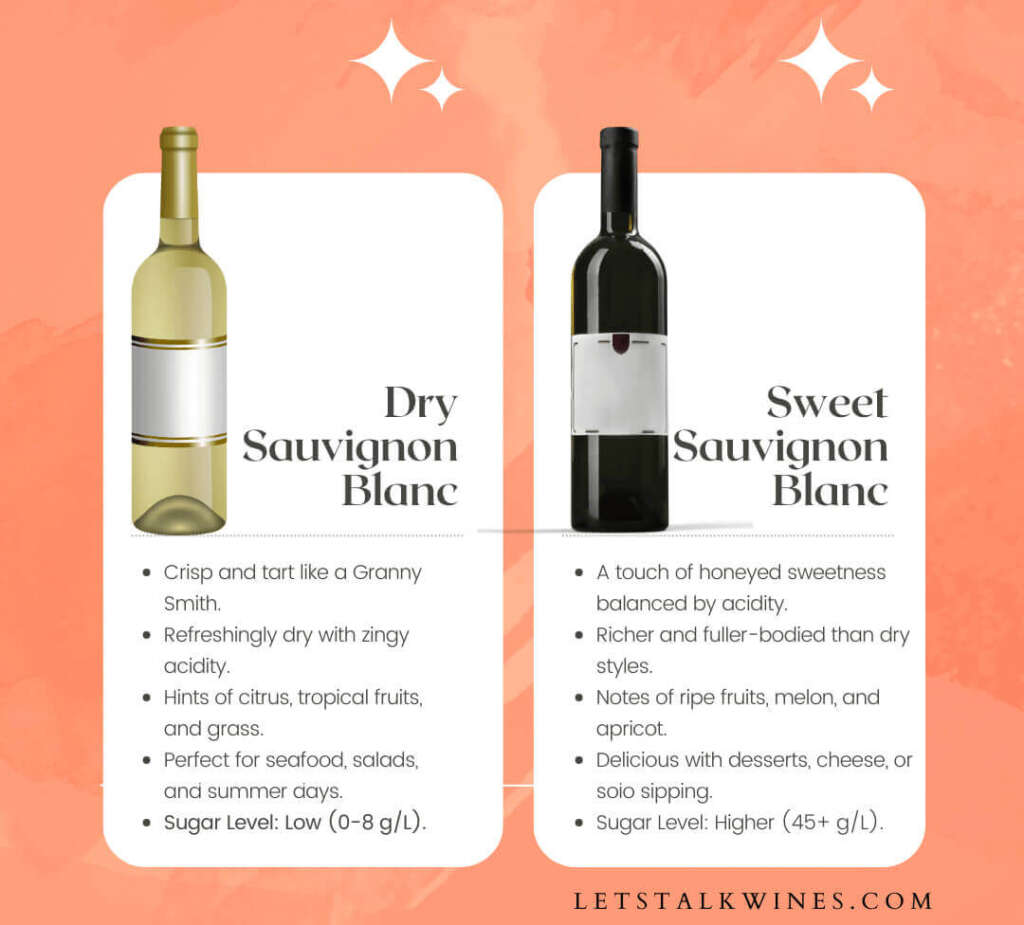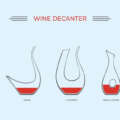Wine connoisseurs often utter the phrase “crisp and dry” when referring to Sauvignon Blanc. This hugely popular white wine bursts with racy acidity and flavors like lime, lemon grass and passionfruit. But is Sauvignon Blanc sweet or dry? — is it truly dry or does some sweetness hide behind that zippy profile? – The short answer it is a dry white wine known for its crisp acidity and light body, with very little residual sugar.
As a self-proclaimed wine enthusiast on a mission to discover the truth, I set out to unravel the mystery of Sauvignon Blanc sweetness levels. Keep reading to explore my tasting discoveries across New Zealand, France and California. By the end, you’ll know exactly where falls Sauvignon Blanc on the dry to sweet spectrum.
A Quick Sauvignon Blanc Primer
First, a fast Sauvignon Blanc overview for newbies like me. Sauvignon Blanc is a white wine grape originally from the Bordeaux region of France. It’s now grown worldwide, most famously in New Zealand and France where it makes up some of the most popular white wines. Compared to other whites, Sauv Blanc is described as having:
- Very high acidity
- Flavors of lime, grapefruit, gooseberries
- Grassy, herbal, mineral notes
- Crisp light body and dry finish
Apparently it grows well in cooler regions which allow those tart, green flavors to shine through. Warmer locations can make the grapes ripen too much and taste more overwhelmingly fruity. That background gave me my first clue – maybe those tropical fruit notes are controlled in cooler New Zealand and come from the grapes themselves, not added sweetness?
I had to learn more.
Is Sauvignon Blanc Sweet or Dry Wine?
Before investigating further on Sav Blanc’s sweet levels, I needed a refresher on how sweetness works in wine. Here’s an overview:
- Residual sugar – The natural grape sugar leftover after initial fermentation ends. Measured in grams per liter (g/L).
- Dry wine – Has very low residual sugar, under 4 g/L. Tastes tart, not sweet.
- Sweet wine – Has much higher sugar levels above 45 g/L for a syrupy texture.
Got it. So by measuring residual sugar amounts, you can clearly define whether a wine fits in dry versus sweet taste categories.
The vast majority of Sauvignon Blanc wines fall squarely in the dry to medium-dry category. Think zesty, crisp, and refreshing, like biting into a Granny Smith apple with a whisper of citrus sunshine.
While most Sauv Blancs boast minimal sugar and a vibrant acidity, there are exceptions:
Late-harvest Sauvignon Blancs, where grapes bask in extra sunshine, offer a touch of sweetness beautifully balanced by the signature acidity. Imagine a delicate honeyed kiss on a crisp Granny Smith canvas. Although, Late-harvest styles are relatively rare, like quirky cousins in the dry wine family, adding a unique twist to the classic grape.
So, when you reach for a glass of Sauvignon Blanc, expect a bone-dry to pleasantly tart experience, perfect for refreshing your palate and pairing with seafood, salads, or simply enjoying on a warm day. But if you stumble upon a late-harvest gem, be prepared for a delightful surprise – a touch of sweetness nestled within the classic crispness.
In short:
Most Sauvignon Blancs: Dry & refreshing, low sugar, high acidity.
Late-harvest styles: Touch of sweetness, beautifully balanced, relatively rare.

Why Does Sauv Blanc Tend Towards the Dry Side
I spoke with a winemaker friend of mine who explained me several reasons why Sauvignon Blanc typically ferments almost fully dry:
Judging Perceived Sweetness By Comparison
To test perceived sweetness levels myself, I purchased three different white wines to taste side-by-side:
- Whitehaven Sauvignon Blanc from Marlborough, New Zealand
- La Crema Chardonnay from Sonoma Coast
- St. Urbans-Hof Riesling from Mosel, Germany
I sipped each wine solo, then together, really focusing on acidity, fruit flavors and overall taste sensations. These were my conclusions:
Sauvignon Blanc – Mouthwatering and tart with dominant flavors of lime, lemon and grapefruit. Clean mineral finish. Bone dry!
Chardonnay – Buttery apple notes with hint of sweet oak and toast. Medium acidity for smooth mouthfeel with subtle sweetness.
Riesling – Peach, nectarine and honey leap out backed by lively acid spine. Clearly fruit-forward sweetness.
It became obvious how dry and piercing the NZ Sauv Blanc tasted next to those rounder, low-acid whites. If all three wines were people, the Sav Blanc would be a hyper, loud-mouthed chatterbox! Zero signs of hidden sweetness to my taste buds.
What The Sugar Numbers Show
As an engineer by day, numbers speak loudly to me. So beyond tasting different Sauv Blancs, I did research online for actual residual sugar measurements. Here’s how common levels stack up across white grape varieties:
- Sauvignon Blanc – 2 to 3 g/L
- Chardonnay – 5 to 7 g/L
- Riesling – 20 to 40 g/L
Considering anything under 4 g/L reads as fully “dry” and my SB clocked in at 3 g/L or less – case closed! Technical data sealed the deal on Sauvignon Blanc’s dry personality.
When Sweetness Sneaks In
Out of curiosity, under what circumstances does Sav Blanc push into slightly sweet territory? I asked a few sommeliers who pointed towards wines made in these unique styles:
- Late harvest – Grapes are left extra long before picking, becoming very ripe and flavor concentrated. The wines end up mildly sweet.
- Botrytized – A beneficial bacteria called Botrytis occasionally infects grapes, evaporating water content while enhancing honeyed complexity. Similar to a French Sauternes.
- Oaked – Barrel fermentation or aging swaths razor-sharp Sav Blanc in a creamy hint of caramel and spice sweetness.
So apparently a small subset of “sticky” Sav Blancs exist…but they remain the rare exceptions! Best estimates show over 90% of all Sauvignon Blancs ferment to bone dry status quo.
The Final Resolution on SB Sweetness
Technical deep dives and sugar level analyses confirm it: Sauvignon Blanc is officially off-sweet territory! High acidity reigns supreme, crafting a refreshingly tart character that’s this grape’s signature. Sure, whispers of fruit like citrus and sunshine might peek through, but they never veer into sugary sweetness.
Late-harvest outliers with a touch of balanced sweetness exist, but they’re like the quirky aunt at a family gathering – unique and fun, but not the everyday norm.
So, embrace the dry, the crisp, the invigoratingly tart essence of Sauv Blanc. It’s a symphony of refreshing dryness and tantalizing fruit whispers, ready to quench your thirst and awaken your senses with every sip.
Raise a glass, then, to Sauvignon Blanc, the undisputed champion of dry delight!
FAQs:
Which Sauvignon Blanc is sweeter?
Most are bone-dry, but late-harvest styles bask in sunshine for a touch of sweetness balanced by acidity, while off-dry styles playfully linger with a fruity whisper of sugar. Think sunshine grapes and mischievous winks!
What is the sweetest wine?
The sweetness spectrum in wines is vast! Dessert wines like Sauternes, Ice Wine, and Tokaji reign supreme, with over 50 g/L of residual sugar. Late-harvest and off-dry styles of various grape varietals also offer sweetness.
Is Pinot Grigio or Sauvignon Blanc sweeter?
Both typically fall into the dry category, but Pinot Grigio can sometimes be made in a slightly sweeter, off-dry style. Generally, Sauvignon Blanc retains its signature crisp acidity, making it perceived as drier.
Which is the sweetest white wine?
This depends on your personal preference! Moscato d’Asti and Gewürztraminer are known for their pronounced sweetness, while Riesling offers a range of styles from dry to dessert-like. Sauvignon Blanc, in its classic form, remains firmly on the dry side.
Is Chardonnay a sweet Wine?
Chardonnay’s sweetness spectrum is broader than Sauvignon Blanc. While many Chardonnays are dry, malolactic fermentation and oak aging can contribute buttery, toasty notes that can be perceived as sweeter. Some dessert and late-harvest Chardonnay styles also exist.



